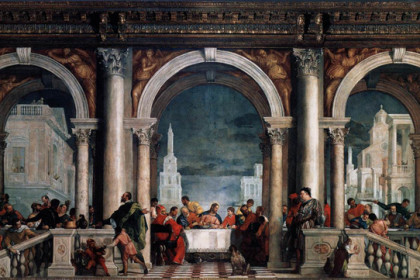
La rivalutazione del gatto giunge con Leonardo da Vinci, che lo definì “un capolavoro” e gli dedicò numerosi studi. Nel famoso “foglio di schizzi” datato 1490, in cui il gatto è raffigurato nei suoi atteggiamenti abituali, nascose ben 73 giochi enigmistici tutt’ora irrisolti. Nell’angolo in basso a destra del foglio, accanto al timbro della Royal Library, il professor Vezzosi ha identificato il disegno sintetico di un animale che “a un’attenta osservazione risulta essere un gatto alato”. [immagine 1]
Hieronymus Bosch lo pone nel giardino dell’Eden, mentre se ne va in giro con un topino in bocca [immagine 2], altri come Dürer, Cornelisz Van Haarlem, Hendrick Goltzius lo seguiranno ponendolo accanto ad Adamo e a Eva [immagini 3 e 4]. Eppure, ancora, nella pittura ad argomento sacro lo vediamo associato al tradimento e al male, come in alcune opere di Paolo Veronese o del Bassano che lo ritraggono accanto a Giuda [immagini 6, 7, 8], mentre il Tintoretto lo fa combattere con un gallo nella Nascita di San Giovanni Battista, quasi a simboleggiare la lotta della luce contro le tenebre [immagine 9]. Per tutto il Rinascimento, il caro felino subirà quest’atteggiamento ambivalente: per esempio, ancora nella Natività del Barocci una gatta allatta ai
Cat revaluation arrives with Leonardo da Vinci, who described it as “a masterpiece” and devoted several studies to it. In the famous “sheet of sketches” dated 1490 in which the cat is depicted in his habitual attitudes, he hid some 73 puzzles still unresolved. In the bottom-right of the page, next to the stamp of the Royal Library, Professor Vezzosi identified the synthetic design of an animal that “at a careful observation appears to be a winged cat.”
Hieronymus Bosch puts it in the garden of Eden, as it goes around with a mouse in its mouth, others such as Dürer, Cornelisz Van Haarlem, Hendrick Goltzius will follow him by placing it next to Adam and Eve. Yet, again, in sacred painting we see it associated with betrayal and evil, as in some of the works by Paolo Veronese or Bassano which depict it next to Judah, while Tintoretto makes it fight with a rooster in the Birth of St. John the Baptist, as if to symbolize the struggle of light against darkness [image 4]. Throughout the Renaissance, the beloved feline will experience this ambivalent attitude: for example, even in the Nativity of Barocci a cat feeds its kittens at the feet of the Virgin Mary cradling Jesus in the evocation of a double maternal love.
To sacred is joined, however, profane symbolism linked to humoral theory of Hippocrates and Galen, and the cat takes one of the four temperaments of man, the “choleric”. In the sixteenth century the cat is almost absent in the depictions of saints: even St. Gertrude, saint patron of cats, in paintings, is mostly surrounded by rats. Incidentally, the Sodoma shows us a cat disputing against a dog in San Benedetto that feeds the monks, or we see it play with a turtle in the study of Dionysius the Carthusian, by the Spanish Vicente Carducho.
The era of Luther Reformation and Counter-Reformation gives us some curious paintings of religious subjects resulting from a cute episode: a Franciscan monk, Thomas Murner, strongly opposed to Luther, and he compared him to an evil and crazy cat. Luther called him “Murnarr” (from “narr”, “fool”; Murr or Murner are traditional names given to cats in Germanic countries) or crazy cat. In response to the affront, Murner printed an incision on the flyleaf of his anti-lutheran pamphlet Of the big mad Lutheran where a monk-cat (Murner) tramples a fool man on the floor (Luther, an Augustinian dressed monk). The cat extracted from the mouth of the opponent some figurines of fools. It seems that even Renaissance had clear ideas about cat: angel or devil?
To be continued
 English
English  Italiano
Italiano 



